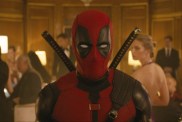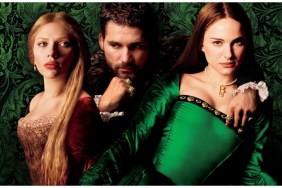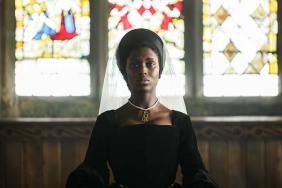“The Other Boleyn Girl” Cast:
Natalie Portman as Anne Boleyn
Scarlett Johansson as Mary Boleyn
Eric Bana as Henry Tudor
Jim Sturgess as George Boleyn
Mark Rylance as Sir Thomas Boleyn
Kristin Scott Thomas as Lady Elizabeth Boleyn
David Morrissey as The Duke of Norfolk
Benedict Cumberbatch as William Carey
Oliver Coleman as Henry Percy
Ana Torrent as Katherine of Aragon
Eddie Redmayne as William Stafford
Tom Cox as Rider
Michael Smiley as Physician
Montserrat Roig de Puig as Lady in Waiting
Juno Temple as Jane Parker
Directed by Justin Chadwick
“Penelope” Cast
Christina Ricci as Penelope
James McAvoy as Max
Catherine O’Hara as Jessica Wilhern
Reese Witherspoon as Annie
Peter Dinklage as Lemon
Richard E. Grant as Franklin Wilhern
Simon Woods as Edward Vanderman Jr.
Ronni Ancona as Wanda
Jason Thornton as Shane
Directed by Mark Palansky
Analysis:
While comparing a light romantic fantasy and a heavy drama based on historical events might seem like an effort that serves little purpose, two movies opening this weekend have far more in common than might be apparent on the surface. Not only are they both ambitious first features by their respective filmmakers with a mix of known stars and young guns, but in an odd way, both films use arranged marriage as the basis for their plots.
The Boleyn sisters Mary and Anne (Scarlett Johansson, Natalie Portman) receive constant pressure from their uncle to elevate their family’s status by seducing the married King of England Henry Tudor (Eric Bana) and winning his heart by giving him a male heir, though their carefully laid plans are plagued by misfortune that leads to misery for their entire family, causing an irrepairable rift between the sisters.
Wealth and status also plays a large part in the plot for “Penelope,” starring Christina Ricci as the daughter of a wealthy family who suffers from a long-time family curse that’s given her the snout of a pig since birth. Her overprotective mother (Catherine O’Hara) keeps Penelope holed up in their mansion, but desperately tries to find a wealthy suitor who can bear the sight of the girl to finally break the curse. A sleazy tabloid photographer, played by Peter Dinklage, sees a chance to exploit the family’s standing by hiring an out of luck gambler (James McAvoy) to pretend he’s a suitor and expose the poor girl’s deformity.
“Boleyn” clearly has an advantage by being based on a popular novel by Phillipa Gregory and being adapted by Peter Morgan, the award-winning playwright and screenwriter of “The Queen.” The sisters’ interactions with the king are told in a fairly linear manner, as Anne’s brash nature forces the king to set his sights on her younger married sister Mary, who is instructed to allow the king’s advances because it’s so important to the family’s future. After being exiled to France, Anne returns and wins the king over with her newfound wiles, but her inability to bear him a son drives her sanity into a downwards spiral.
Both movies’ influences are worn so openly on their sleeves that it’s almost impossible to avoid comparisons with far better movies. The opening title sequence from “Boleyn” so similarly resembles the opening of “Elizabeth,” a movie that’s become a template for how to make a costume drama, and a reference that becomes clearer as the film progresses. Director Mark Palansky gives “Penelope” a distinctive fantasy world using clever and inventive visuals that resemble those of Jean-Pierre Jeunet (“Amelie”) or Terry Gilliam, creating an environment that often traverses the line between the whimsical and the outright silly.
It’s unclear who thought it would be a wise move to hide Christina Ricci’s cuteness behind a hideous pig snout, but even without the distinctive make-up, she’s not strong enough as an actress to carry a film like this, so the film relies more on a supporting cast forced to resort to embarrassing slapstick at times. The usually great Catherine O’Hara does a good job getting laughs, as does Richard E. Grant as Penelope’s father, but neither has to fall quite as far into the general silliness suffered by James McAvoy, who is as charming as ever despite an awkward American accent.
With a much stronger script to work from, “Boleyn” is driven by another great performance by Natalie Portman that plays to her strengths as an actress, and the richness of her performances tends to overshadow the comparably flat and lifeless performance by Johansson. Eric Bana carries a suitably regal presence as King Henry VIII, but his dashing good looks take away from the illusion of this being the royal best known for his abuse of wives and mistresses alike. Justin Chadwick fills the smaller roles with some of England’s finest young talent including Jim Sturgess from “Across the Universe,” Eddie Redmayne from “The Good Shepherd” and Benedict Cumberbatch, who played McAvoy’s rival in the underrated “Starter for 10.” It’s hard to find many likeable characters but David Morrissey as the sister’s uncle comes closest to an antagonist as he acts like the King’s pimp by finding him new women to bed, destroying the sisters’ relationship in the process.
If the references to “Elizabeth” in “Boleyn” weren’t obvious from the opening, then the closing title epilogue drives home the point by reminding us that the legendary queen was the illegitimate daughter of Anne Boleyn, making this movie somewhat of an unauthorized prequel. Being based on historic events and figures causes the most troubles for “Boleyn” because few will appreciate the film’s inference that the current queen’s bloodline was derived from Anne’s rape by Henry Tudor. The second half of the film gets so dark and ugly as things go from bad to worse to keep with Anne’s history, but it’s a jarring departure from the romanticism of the first half. The film also sends off mixed messages by having Anne’s feminism be overpowered and crushed by the misogyny of the times.
Needless to say, “Penelope” is a far more innocent film, and without having to work from historic groundwork, it’s free to explore lighter fairy tale situations. So many characters and ideas are thrown into the mix that the film often feels out of control, even as it tries to maintain a strictly delineated three-act structure. Much of the first half of the movie deals with Penelope’s mother trying to find a suitor and her courtship by McAvoy via two-way mirror, while the second act becomes a “fish out of water” story of Penelope leaving her sheltered life to explore the outside world. McAvoy disappears from the picture at this point, replaced by the film’s co-producer Reese Witherspoon as Annie, a chatty fast-talking young woman who befriends Penelope. Despite the similarities between Annie and Tracy Flick from “Election,” it’s a mostly irrelevant character that distracts from the earlier fantasy set-up.
Visually, the films couldn’t be more different, but “Boleyn” is surprisingly unflashy and not very glamorous compared to other costume dramas, while “Penelope” is an amazing achievement in production design with gorgeous sets that makes you wonder what Palansky might have done if he helmed “Boleyn” instead, since the extra effort in the visuals will likely be lost on the intended audience for “Penelope.”
The Bottom Line:
“Boleyn” is an ambitious film that tries to tell a little known piece of history about two sisters involved with Henry the VIII in an entertaining way, but ultimately fails due to the dark and dreary nature of the final act. In the hands of a more competent director, Peter Morgan’s strong script might have been turned into something more memorable. “Penelope” seems like a fairly misguided and flimsy premise, so the fact that it works at all is an achievement in itself, and however one can fault the execution, there’s something ironic about its sweet message about accepting one’s own faults. Ultimately, neither film is great, though neither is horrendous, and if one had to pick one to see, the strong script and Portman’s performance in “The Other Boleyn Girl” allows it to win… but only by a nose.










